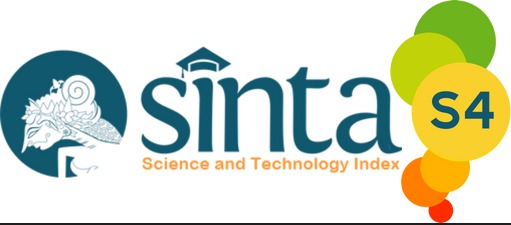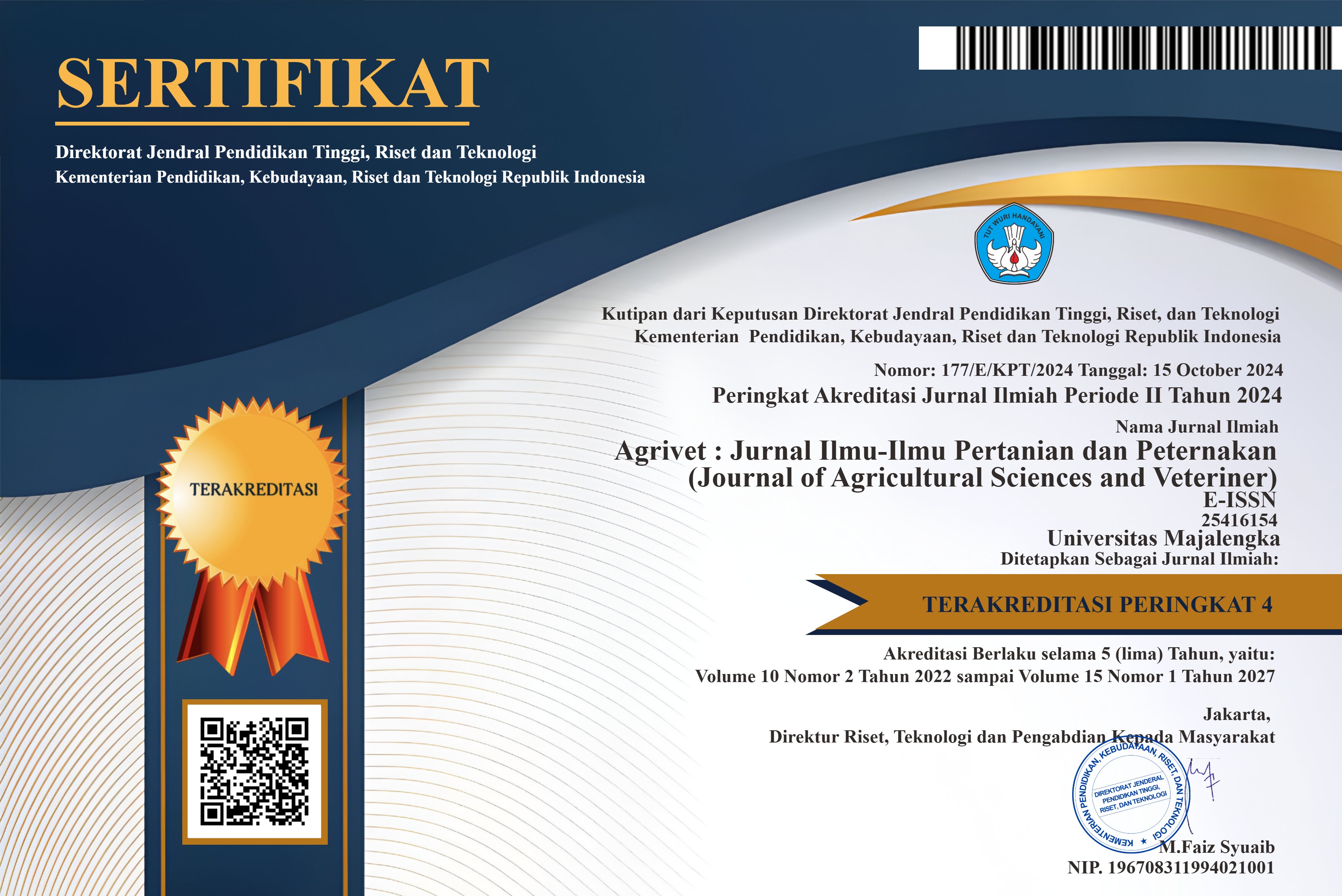Ketahanan pangan rumah tangga peternak domba di Kecamatan Pamulihan Kabupaten Sumedang Jawa Barat
DOI:
https://doi.org/10.31949/agrivet.v13i1.13961Abstract
Sheep farming was one of the primary sources of household income, playing a crucial role in sustaining the livelihoods of farming households, particularly in rural areas. This study aimed to analyze the level of food security among sheep-farming households and determine the contribution of sheep farming to meeting household food needs. The research was conducted in Pamulihan Subdistrict, Sumedang Regency, with a total of 91 households selected proportionally from five villages. The method employed was a survey conducted through structured interviews and energy consumption measurement using the 3-day, 24-hour food recall method. The results showed that the average annual income from sheep farming was IDR 4,144,716.90 per business unit, equivalent to IDR 342,642.90 per month, comprising food expenditure of IDR 1,665,977.98 per month and non-food expenditure of IDR 1,251,089.59 per month. The average household energy consumption was recorded at 5.929.78 kcal/household/day (89.95% of the Recommended Dietary Allowance), and protein consumption was 164.67 grams/household/day (86.81% of the Recommended Dietary Allowance), with the share of food expenditure reaching 57.11%. The distribution of household food security status included 35.16% food-secure, 18.68% food-insecure, 26.37% food-vulnerable, and 19.78% food-secure. Sheep farming served as an additional source of income as well as a form of savings that could be liquidated when needed, particularly in urgent financial situations, to access food. However, its contribution to food expenditure only reached 23,47%. Therefore, it was important to increase household income through income diversification and to promote the development of sheep farming as a strategy to improve welfare and food security in rural areas.
Keywords:
food security, household, contribution, sheep farming businessDownloads
References
Ahmadi Dehrashid A, Bijani M, Valizadeh N, Ahmadi Dehrashid H, Nasrollahizadeh B, Mohammadi A. 2021. Food security assessment in rural areas: evidence from Iran. Agric Food Secur. 10(1). https://doi.org/10.1186/s40066-021-00291-z
Annisa A, Saputri BGD, Asmara R, Fahriyah F, Hanani N. 2022. Analysis of Household Income and Food Security of Watermelon Farmers During The Covid-19 Pandemic in Lamongan Regency. Agro Ekonomi. 33(2):91. https://doi.org/10.22146/ae.76175
Badan Pusat Statistik (BPS). 2025. Kabupaten Sumedang Dalam Angka 2024. Badan Pusat Statistik. Sumedang.
Badan Pusat Statistik (BPS). 2024. Kabupaten Sumedang Dalam Angka 2023. Badan Pusat Statistik. Sumedang.
Badan Pusat Statistik (BPS). 2021. Kabupaten Sumedang Dalam Angka 2020. Badan Pusat Statistik. Sumedang.
Banna MH Al, Sayeed A, Kundu S, Kagstrom A, Sultana MS, Begum MR, Khan MSI. 2022. Factors associated with household food insecurity and dietary diversity among day laborers amid the Covid-19 pandemic in Bangladesh. BMC Nutr. 8(1). https://doi.org/10.1186/s40795-022-00517-8
Beacom E, McLaughlin C, Furey S. 2024. Household Food Consumption Typologies: Examining Population Adherence to Healthy Eating Guidelines for Evidence-Informed Policy Making. J Consum Policy (Dordr). 47(2):297–315. https://doi.org/10.1007/s10603-024-09565-y
Diehl JA, Oviatt K, Chandra AJ, Kaur H. 2019. Household food consumption patterns and food security among low-income migrant urban farmers in Delhi, Jakarta, and Quito. Sustainability (Switzerland). 11(5). https://doi.org/10.3390/su11051378
Indeks Ketahanan Pangan. 2023.
Jha DK. 2019. The Role of Livestock in Rural Households in Nepal. International Journal of Publication and Social Studies. 4(2):67–91. https://doi.org/10.18488/journal.135.2019.42.67.91
Kecamatan K, Pamulihan P. 2023. Kecamatan Pamulihan Dalam Angka 2023 Badan Pusat Statistik Kabupaten Sumedang Bps-Statistics Of Sumedang Regency.
Krisna R, Harry. 2014. Hubungan Tingkat Kepemilikan dan Biaya Usaha dengan Pendapatan Peternak Sapi Potong di Kabupaten Sukabumi Provinsi Jawa Barat (Studi Korelasi). Artikel Aplikasi Manajemen. 12.
Kuswaryan S (2022). Strategi Nafkah untuk Kenyamanan Finansial Rumah Tangga Peternak Domba di Perdesaan. Livelihood Strategy for Financial Well Being in Rural Household Sheep Farming. (Survey Di Wilayah Kerja Koperasi Peternak Serbausaha Riungmukti Kecamatan Kalapanunggal Kabupaten Sukabumi). Disertasi Fakultas Peternakan Universitas Padjadjaran.
Kuswaryan S, Firmansyah C, Daud AR, Fitriani A. 2024. Implementasi Dan Respon Peternak Terhadap Inovasi Pembiayaan Penggemukan Domba Qurban “Model Ekobis 30-70.” Artikel Difusi Ipteks Legowo [Internet]. 2(1):1–13. https://doi.org/10.62242/jdil.v2i1.23
Kuswaryan S, Firmansyah C, Hadiana MH. 2020. Usaha Ternak Domba sebagai Jalur Keluar dari Kemiskinan Buruh Tani di Perdesaan. Jurnal Ilmu dan Teknologi Peternakan Tropis. 7(3):189. https://doi.org/10.33772/jitro.v7i3.11396
Kuswaryan S, Fitriani A, Daud AR, Firmansyah C, Indah U, Rahmah L. 2024. Mimbar Agribisnis : Jurnal Pemikiran Masyarakat Ilmiah Berwawasan Agribisnis Analisis Ketahanan Pangan Rumah Tangga Peternak Domba (Kasus pada Rumah Tangga Peternak Domba di Kecamatan Kertajati Kabupaten Majalengka, Jawa Barat) Food Security Analysis of Sheep Farmers Households (Case in Sheep Farmers Households in Kertajati District, Majalengka Regency West Java). Januari. 11(1):625–635.
Kuswaryan S, Fitriani A, Nurjanah S. 2016. Peran Usaha ternak Domba Sebagai Pengaman Finansial Keluarga Di Perdesaan Kasus Usaha Ternak Domba Pola Gaduhandi Kawasan Perdesaan Kecamatan Cikedung Kabupaten Indramayu Jawa Barat.
Maxwell D, Levin C, Armar-Klemesu M, Ruel M, Morris S, Ahiadeke C. Urban Livelihoods and Food and Nutrition Security in Greater Accra, Ghana in col labo ra tion with Noguchi Me Mo Rial In Sti Tute For Medi Cal Re Search World Health Or Gani Za Tion.
Merryana Adriani SKM. 2016. Pengantar gizi masyarakat. Prenada Media.
Pamulihan K, Angka D. A Dalam Angka 2023 Badan Pusat Statistik Kabupaten Sumedang Bps-Statistics Sumedang Regency.
Peraturan Menteri Kesehatan Republik Indonesia Nomor 28 Tahun 2019 Tentang Angka Kecukupan Gizi Yang Dianjurkan Untuk Masyarakat Indonesia.
Pica-Ciamarra U, Tasciotti L, Otte J, Zezza A. 2011. Livestock Assets, Livestock Income and Rural Households Cross-Country Evidence from Household S Livestock Assets, Livestock Income and Rural Households ountry Evidence from Household Surveys Livestock Assets, Livestock Income and Rural Households urveys with support from the Gates Foundation [Internet]. [place unknown]. www.fao.org/es/ESA/riga/.
Pujiriyani. D.W, E. Soetarto, D. A. Santosa, dan I. Agusta. 2018. Deagrarianisasi Dan Dislokasi Nafkah Komunitas Petani Di Pedesaan Jawa: Deagrarianization and Livelihood Dislocation of Peasant Community In Rural Java. Sodality: Jurnal Sosiologi Pedesaan | Vol 6 No 2 Agustus 2018, Hal 137-145. https://doi.org/10.22500/sodality.v6i2.23235
Rachmah MA, Marzuki S. Analisis Faktor-Faktor Yang Mempengaruhi Pangsa Pengeluaran Pangan Rumah Tangga Petani Di Kecamatan Suruh Kabupaten Semarang (Analysis of Factors Affecting The Share of Food Expenditure Household of Farmers in Subdistrict Suruh Semarang Region). [place unknown].
Rusdiana S, Adiati U, Talib C. 2021. Contribution of Agricultural and Sheep Business for Increasing Farmer’s Economic Value. 4:66–84.
Susanti AF. 2019. Hubungan Pendapatan dan Status Ketahanan Pangan Rumah Tangga di Wilayah Pesisir di Kecamatan Sidoarjo Kabupaten Sidoarjo (Studi Penelitian di Dusun Kalikajang Kelurahan Gebang).
FAO. 2011. World Livestock 2011 – Livestock in food security. Rome, FAO. Viale delle Terme di Caracalla. 00153 Rome, Italy. https://www.fao.org/4/i2373e/i2373e00.htm
FAO. 2021. The State of Food Security and Nutrition in the World. FAO, IFAD, UNICEF, WFP and WHO. https://doi.org/10.4060/cb4474en
Wahyuni A, Badrudin R, Ifebri R, Sari P. Analisis Pola Pengeluaran Rumah Tangga Petani… 27 JASc. Journal Agribusiness Sciences [Internet].:2614–6037. https://doi.org/10.30596/jasc.v9i1.23815
Zamrodah Y. 2020. Penyusunan Indeks Ketahanan Pangan Kabupaten Probolinggo.
Published
How to Cite
Issue
Section
License
Copyright (c) 2025 Sekarizky, Cecep Firmansyah, Sondi Kuswaryan

This work is licensed under a Creative Commons Attribution-ShareAlike 4.0 International License.
An author who publishes in the Jurnal Agrivet agrees to the following terms:
- Author retains the copyright and grants the journal the right of first publication of the work simultaneously licensed under the Creative Commons Attribution-ShareAlike 4.0 License that allows others to share the work with an acknowledgment of the work's authorship and initial publication in this journal
- The author is able to enter into separate, additional contractual arrangements for the non-exclusive distribution of the journal's published version of the work (e.g., post it to an institutional repository or publish it in a book) with the acknowledgment of its initial publication in this journal.
- The author is permitted and encouraged to post his/her work online (e.g., in institutional repositories or on their website) prior to and during the submission process, as it can lead to productive exchanges, as well as earlier and greater citation of the published work












